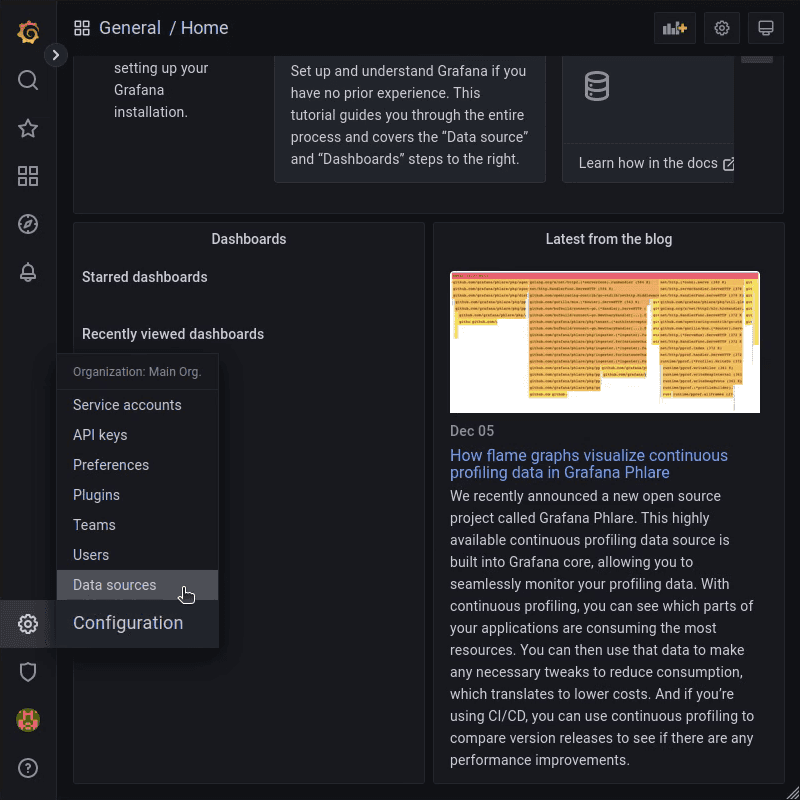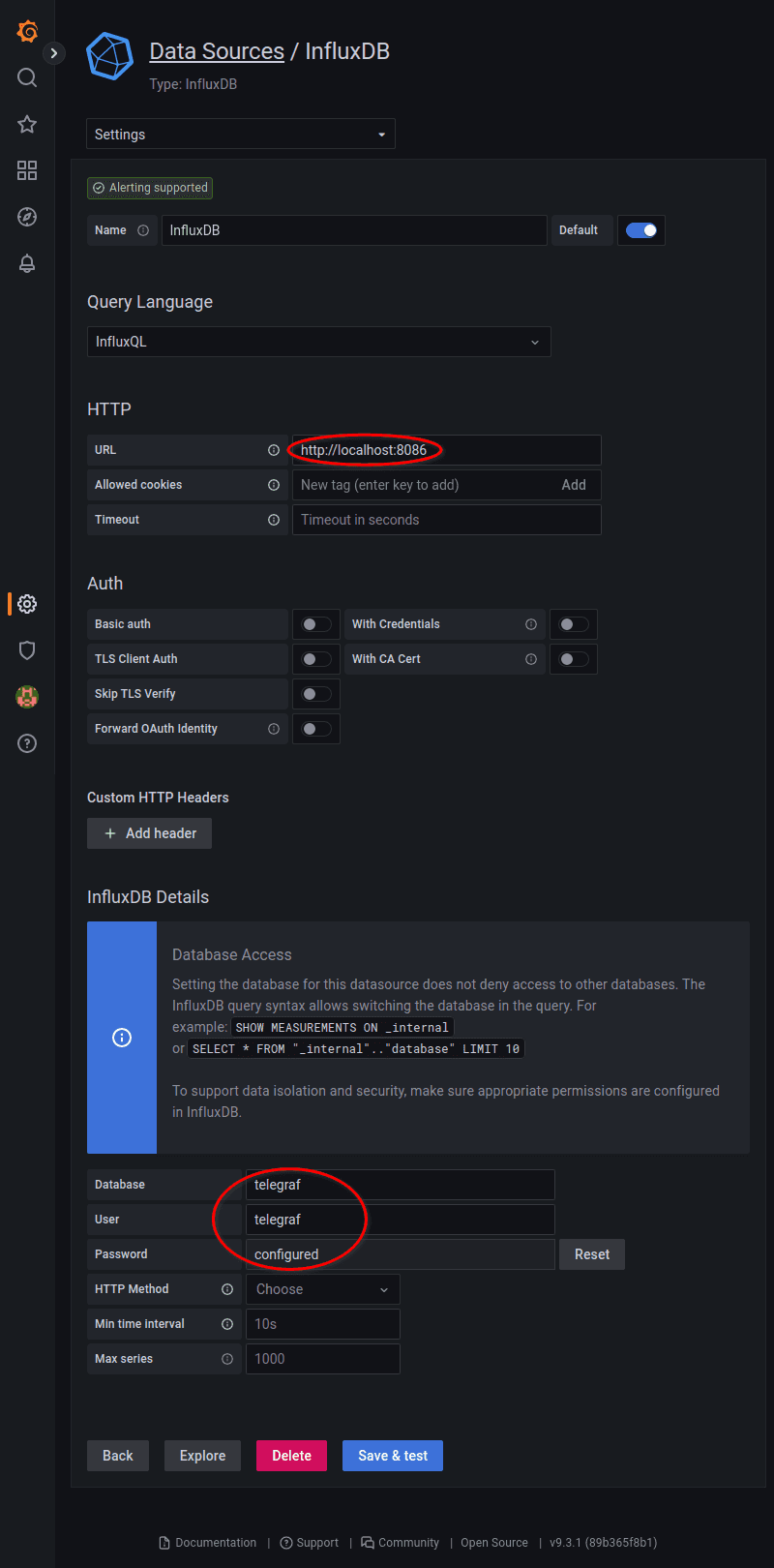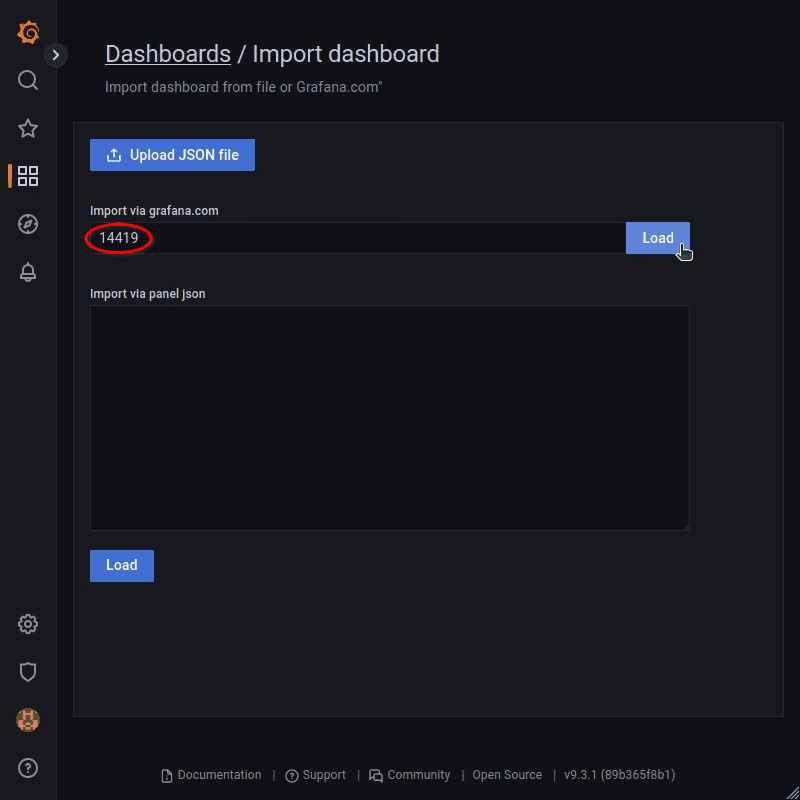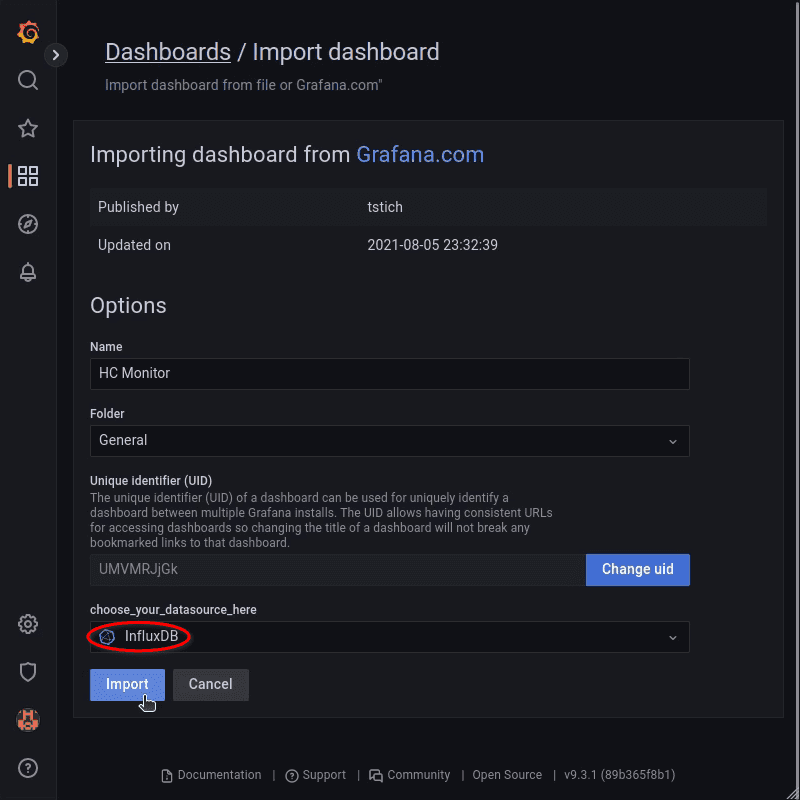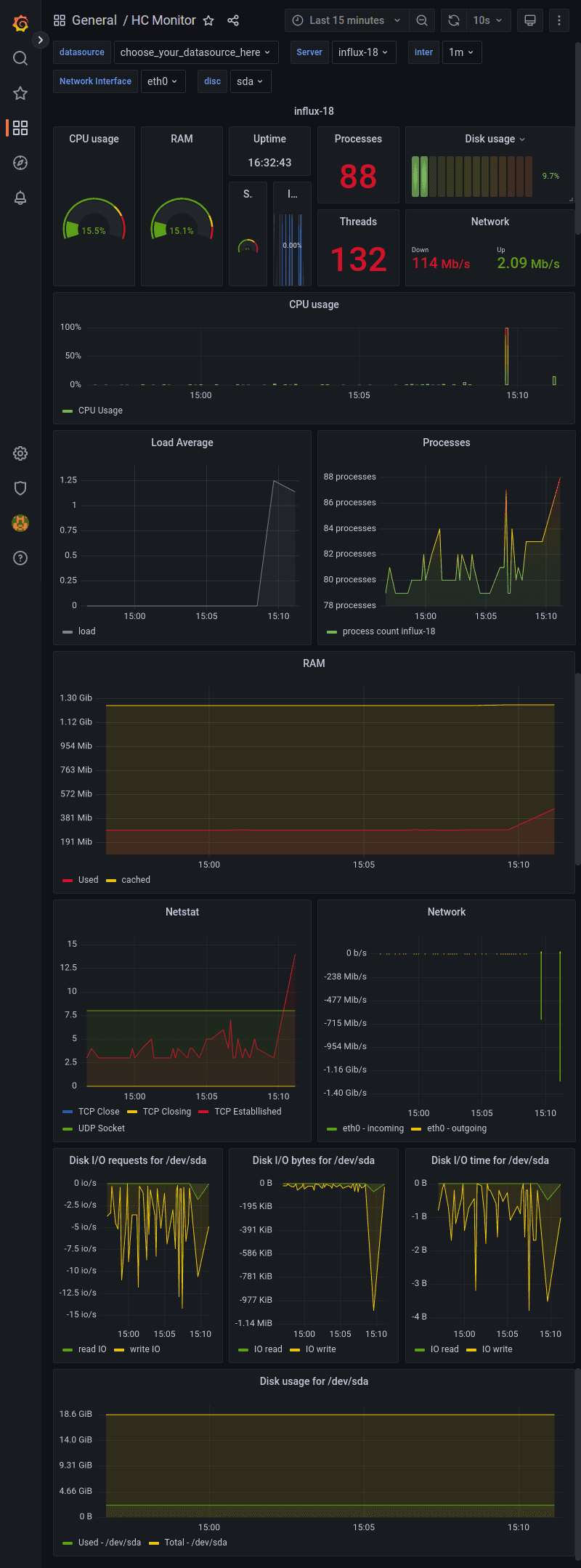Introduction
Grafana is a monitoring software for data visualization. You can display every data, on several graphs or gauges. We will use Telegraf for storing the data in InfluxDB, which will be displayed on a Grafana dashboard.
Prerequisites
For this tutorial, you need a machine/server you want to monitor, e.g. a Cloud server or a Dedicated root server with Ubuntu.
This tutorial has been tested on:
- Ubuntu 22.04
- Ubuntu 20.04
- Ubuntu 18.04
We assume you to be the root user.
And you also need DNS records pointing to the IP address of your server.
DNS records for Grafana:
| Type | Name | Value |
|---|---|---|
| A | grafana | <IPv4 address of your server> |
| AAAA | grafana | <IPv6 address of your server> |
DNS records for InfluxDB:
| Type | Name | Value |
|---|---|---|
| A | influx | <IPv4 address of your server> |
| AAAA | influx | <IPv6 address of your server> |
Step 1 - Install InfluxDB
First, we need to add the InfluxDB repositories to our OS:
curl -sL https://repos.influxdata.com/influxdb.key | apt-key add -
source /etc/lsb-release
echo "deb https://repos.influxdata.com/${DISTRIB_ID,,} ${DISTRIB_CODENAME} stable" > /etc/apt/sources.list.d/influxdb.listAfter that, we need to update and install the package:
apt update
apt install influxdbNow we need to start and start our service and check if it's running without problems:
Starting:
systemctl start influxdbChecking:
systemctl status influxdbThe Output should look similar to this:
● influxdb.service - InfluxDB is an open-source, distributed, time series database
Loaded: loaded (/lib/systemd/system/influxdb.service; enabled; vendor preset: enabled)
Active: active (running) since Mon 2022-12-05 20:34:26 UTC; 9s ago
Docs: https://docs.influxdata.com/influxdb/
Main PID: 6038 (influxd)
Tasks: 8 (limit: 2286)
Memory: 8.7M
CGroup: /system.slice/influxdb.service
└─6038 /usr/bin/influxd -config /etc/influxdb/influxdb.confYour service should be available on the default Port 8086
Now that we have installed InfluxDB correctly, we will go to the influx cli and create a user for authentication.
(Please use a secure password for authentication)
influxCREATE USER telegraf WITH PASSWORD '<password>' WITH ALL PRIVILEGES
show usersThe output should look like this:
user admin
---- -----
telegraf trueLeave the influx cli with the command exit.
Now that we have created the user, we can configure InfluxDB for basic auth.
To do that you have to edit the file /etc/influxdb/influxdb.conf.
Here, uncomment/change the necessary lines to get an output like this:
[http]
# Determines whether HTTP endpoint is enabled.
enabled = true
# The bind address used by the HTTP service.
bind-address = ":8086"
# Determines whether user authentication is enabled over HTTP/HTTPS.
auth-enabled = trueTo refresh our changes to the config, we need to restart InfluxDB
systemctl restart influxdbStep 2 - Install Telegraf
Telegraf will pass the necessary information from the monitored system to InfluxDB.
The packages for Telegraf are located in the same repository as InfluxDB.
If you are installing Telegraf on other machines, do not forget to add a repository as per Step 1 - Install InfluxDB, and then run apt update command.
Install Telegraf with the following command:
apt install telegrafNow we have to edit the /etc/telegraf/telegraf.conf.
Here, go to the [[outputs.influxdb]] section, uncomment username and password, and also specify the password you have set in Step 1 - Install InfluxDB.
## HTTP Basic Auth
username = "telegraf"
password = "<password>"We need to add a config file for the collection of some extra data.
Create the file /etc/telegraf/telegraf.d/netquery.conf, and paste the following content:
[[inputs.net]]
[[inputs.netstat]]It's possible to check your new configuration, isolated from the running Telegraf service:
telegraf --test --config /etc/telegraf/telegraf.d/netquery.confIf the test runs well, the output should look similar to this:
2022-12-05T17:32:50Z I! Starting Telegraf 1.24.4
2022-12-05T17:32:50Z I! Available plugins: 222 inputs, 9 aggregators, 26 processors, 20 parsers, 57 outputs
2022-12-05T17:32:50Z I! Loaded inputs: net netstat
2022-12-05T17:32:50Z I! Loaded aggregators:
2022-12-05T17:32:50Z I! Loaded processors:
2022-12-05T17:32:50Z W! Outputs are not used in testing mode!
2022-12-05T17:32:50Z I! Tags enabled: host=influx-18
> net,host=influx-18,interface=eth0 bytes_recv=104995256i,bytes_sent=4023451i,drop_in=0i,drop_out=0i,err_in=0i,err_out=0i,packets_recv=67591i,packets_sent=61189i 1670261571000000000
> net,host=influx-18,interface=all icmp_inaddrmaskreps=0i,icmp_inaddrmasks=0i,icmp_incsumerrors=0i,icmp_indestunreachs=49i,icmp_inechoreps=0i,icmp_inechos=14i,icmp_inerrors=10i,icmp_inmsgs=64i,icmp_inparmprobs=0i,icmp_inredirects=0i,icmp_insrcquenchs=0i,icmp_intimeexcds=1i,icmp_intimestampreps=0i,icmp_intimestamps=0i,icmp_outaddrmaskreps=0i,icmp_outaddrmasks=0i,icmp_outdestunreachs=200i,icmp_outechoreps=14i,icmp_outechos=0i,icmp_outerrors=0i,icmp_outmsgs=214i,icmp_outparmprobs=0i,icmp_outredirects=0i,icmp_outsrcquenchs=0i,icmp_outtimeexcds=0i,icmp_outtimestampreps=0i,icmp_outtimestamps=0i,icmpmsg_intype11=1i,icmpmsg_intype3=49i,icmpmsg_intype8=14i,icmpmsg_outtype0=14i,icmpmsg_outtype3=200i,ip_defaultttl=64i,ip_forwarding=2i,ip_forwdatagrams=0i,ip_fragcreates=0i,ip_fragfails=0i,ip_fragoks=0i,ip_inaddrerrors=13i,ip_indelivers=59198i,ip_indiscards=0i,ip_inhdrerrors=0i,ip_inreceives=59214i,ip_inunknownprotos=1i,ip_outdiscards=20i,ip_outnoroutes=0i,ip_outrequests=57568i,ip_reasmfails=0i,ip_reasmoks=0i,ip_reasmreqds=0i,ip_reasmtimeout=0i,tcp_activeopens=20i,tcp_attemptfails=25i,tcp_currestab=3i,tcp_estabresets=0i,tcp_incsumerrors=17i,tcp_inerrs=17i,tcp_insegs=81946i,tcp_maxconn=-1i,tcp_outrsts=49871i,tcp_outsegs=75572i,tcp_passiveopens=130i,tcp_retranssegs=150i,tcp_rtoalgorithm=1i,tcp_rtomax=120000i,tcp_rtomin=200i,udp_ignoredmulti=0i,udp_incsumerrors=0i,udp_indatagrams=67i,udp_inerrors=0i,udp_noports=251i,udp_outdatagrams=106i,udp_rcvbuferrors=0i,udp_sndbuferrors=0i,udplite_ignoredmulti=0i,udplite_incsumerrors=0i,udplite_indatagrams=0i,udplite_inerrors=0i,udplite_noports=0i,udplite_outdatagrams=0i,udplite_rcvbuferrors=0i,udplite_sndbuferrors=0i 1670261571000000000
> netstat,host=influx-18 tcp_close=0i,tcp_close_wait=0i,tcp_closing=0i,tcp_established=3i,tcp_fin_wait1=0i,tcp_fin_wait2=0i,tcp_last_ack=0i,tcp_listen=5i,tcp_none=22i,tcp_syn_recv=0i,tcp_syn_sent=0i,tcp_time_wait=0i,udp_socket=8i 1670261571000000000Reload Telegraf service to apply changes:
systemctl reload telegrafStep 3 - Install Grafana
Finally, we can install Grafana for visualization of the InfluxDB tables and values, which are created by Telegraf.
Therefore, we install the necessary software and add the Grafana repository. After that, we update and install Grafana.
curl -sL https://packages.grafana.com/gpg.key | apt-key add -
echo "deb https://packages.grafana.com/oss/deb stable main" > /etc/apt/sources.list.d/grafana.list
apt update
apt install grafanaStart and check the status:
systemctl start grafana-server
systemctl status grafana-serverIf everything runs well, also add it to the autostart:
systemctl enable grafana-serverStep 4 - Install Nginx
If you only use Grafana/InfluxDB on your local machine and don't expose it to the Internet, you don't need to secure your connection.
In this tutorial, we will use an nginx webserver to redirect the traffic and get a certificate for grafana.example.com and influx.example.com via certbot.
Install required packages:
apt install certbot nginx python3-certbot-nginxCreate a file /etc/nginx/sites-available/proxy with the following content:
server {
listen 80;
listen [::]:80;
server_name influx.example.com;
location / {
proxy_pass http://127.0.0.1:8086;
}
}
server {
listen 80;
listen [::]:80;
server_name grafana.example.com;
location / {
proxy_pass http://127.0.0.1:3000;
proxy_set_header Host $http_host;
}
}This basic configuration has HTTP protocol settings only. Certbot will add HTTPS settings for us later.
Finally, we need to create a symlink to activate the nginx configuration file.
ln -v -s /etc/nginx/sites-available/proxy /etc/nginx/sites-enabled/proxyWe are done with the nginx configuration. It's time to get certificates. Simply run:
certbotCertbot finds domains in your nginx configuration. It will ask you some simple questions. Answer 2 to the question about redirecting.
Step 5 - Add a Data Source and a Dashboard
Go to https://grafana.example.com and log in with the default credentials:
- Username: admin
- Password: admin
After logging in, you are asked to change this password.
After that, go to "Data sources"
Click a big blue "Add data source" button to add a new data source, and then select InfluxDB in the Time series databases section.
Configure it as follows:
- HTTP -> URL:
http://localhost:8086 - InfluxDB Details -> Database:
telegraf - InfluxDB Details -> User:
telegraf - InfluxDB Details -> Password:
<password>
Now that we have a working data source for Grafana, we can start importing a dashboard for your server.
There are plenty of already available dashboards for Telegraf and InfluxDB.
As an example, we will work with a dashboard I created for this tutorial: https://grafana.com/grafana/dashboards/14419.
Enter dashboard ID 14419 and click the Load button.
Rename it to your needs, select "InfluxDB" data source, and import it accordingly.
Now you can see the HC Monitor dashboard in action.
Step 6 - Monitor Other Servers (optional)
To monitor your other servers, you would only need to install Telegraf (Step 2 - Install Telegraf) on the corresponding machine and edit the /etc/telegraf/telegraf.conf file.
Here, we replace http://127.0.0.1:8086 with https://influx.example.com:8086.
[[outputs.influxdb]]
## The full HTTP or UDP URL for your InfluxDB instance.
##
## Multiple URLs can be specified for a single cluster, only ONE of the
## URLs will be written at each interval.
# urls = ["unix:///var/run/influxdb.sock"]
# urls = ["udp://127.0.0.1:8089"]
urls = ["https://influx.example.com"]We also need to add the credentials for the Telegraf user:
## HTTP Basic Auth
username = "telegraf"
password = "<password>"After reloading the Telegraf service, you can now choose another host on your dashboard in Grafana.
Conclusion
You are now able to use Grafana. For example, you can now create additional dashboards and users. Grafana also offers an alerting function in case of e.g. unavailability of a specific target value.
